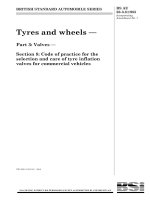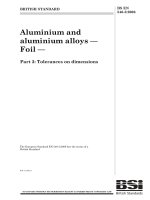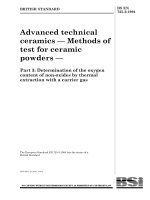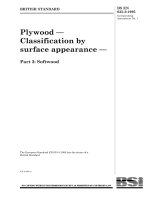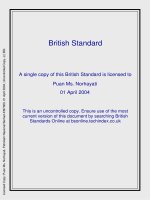Bsi bs en 61158 3 8 2008
Bạn đang xem bản rút gọn của tài liệu. Xem và tải ngay bản đầy đủ của tài liệu tại đây (357.13 KB, 36 trang )
BS EN 61158-3-8:2008
BSI British Standards
Industrial communication
networks — Fieldbus
specifications —
Part 3-8: Data-link layer service
definition — Type 8 elements
NO COPYING WITHOUT BSI PERMISSION EXCEPT AS PERMITTED BY COPYRIGHT LAW
raising standards worldwide™
BRITISH STANDARD
BS EN EN 61158-3-8:2008
National foreword
This British Standard is the UK implementation of EN 61158-3-8:2008. It is
identical to IEC 61158-3-8:2007. Together with all of the other sections of
BS EN 61158-3, it supersedes BS EN 61158-3:2004 which is withdrawn.
The UK participation in its preparation was entrusted to Technical Committee
AMT/7, Industrial communications: process measurement and control, including fieldbus.
A list of organizations represented on this committee can be obtained on
request to its secretary.
This publication does not purport to include all the necessary provisions of a
contract. Users are responsible for its correct application.
© BSI 2009
ISBN 978 0 580 61565 8
ICS 25.040.40; 35.100.20; 35.240.50
Compliance with a British Standard cannot confer immunity from
legal obligations.
This British Standard was published under the authority of the Standards
Policy and Strategy Committee on 31 January 2009.
Amendments issued since publication
Amd. No.
Date
Text affected
BS EN 61158-3-8:2008
EUROPEAN STANDARD
EN 61158-3-8
NORME EUROPÉENNE
February 2008
EUROPÄISCHE NORM
ICS 35.100.20; 25.040.40
Partially supersedes EN 61158-3:2004
English version
Industrial communication networks Fieldbus specifications Part 3-8: Data-link layer service definition Type 8 elements
(IEC 61158-3-8:2007)
Réseaux de communication industriels Spécifications des bus de terrain Partie 3-8: Définition des services
des couches de liaison de données Eléments de type 8
(CEI 61158-3-8:2007)
Industrielle Kommunikationsnetze Feldbusse Teil 3-8: Dienstfestlegungen des
Data Link Layer (Sicherungsschicht) Typ 8-Elemente
(IEC 61158-3-8:2007)
This European Standard was approved by CENELEC on 2008-02-01. CENELEC members are bound to comply
with the CEN/CENELEC Internal Regulations which stipulate the conditions for giving this European Standard
the status of a national standard without any alteration.
Up-to-date lists and bibliographical references concerning such national standards may be obtained on
application to the Central Secretariat or to any CENELEC member.
This European Standard exists in three official versions (English, French, German). A version in any other
language made by translation under the responsibility of a CENELEC member into its own language and notified
to the Central Secretariat has the same status as the official versions.
CENELEC members are the national electrotechnical committees of Austria, Belgium, Bulgaria, Cyprus, the
Czech Republic, Denmark, Estonia, Finland, France, Germany, Greece, Hungary, Iceland, Ireland, Italy, Latvia,
Lithuania, Luxembourg, Malta, the Netherlands, Norway, Poland, Portugal, Romania, Slovakia, Slovenia, Spain,
Sweden, Switzerland and the United Kingdom.
CENELEC
European Committee for Electrotechnical Standardization
Comité Européen de Normalisation Electrotechnique
Europäisches Komitee für Elektrotechnische Normung
Central Secretariat: rue de Stassart 35, B - 1050 Brussels
© 2008 CENELEC -
All rights of exploitation in any form and by any means reserved worldwide for CENELEC members.
Ref. No. EN 61158-3-8:2008 E
BS EN 61158-3-8:2008
EN 61158-3-8:2008
-2-
Foreword
The text of document 65C/473/FDIS, future edition 1 of IEC 61158-3-8, prepared by SC 65C, Industrial
networks, of IEC TC 65, Industrial-process measurement, control and automation, was submitted to the
IEC-CENELEC parallel vote and was approved by CENELEC as EN 61158-3-8 on 2008-02-01.
This and the other parts of the EN 61158-3 series supersede EN 61158-3:2004.
With respect to EN 61158-3:2004 the following changes were made:
– deletion of Type 6 fieldbus, and the placeholder for a Type 5 fieldbus data-link layer, for lack of market
relevance;
– addition of new fieldbus types;
– partition into multiple parts numbered 3-1, 3-2, …, 3-19.
The following dates were fixed:
– latest date by which the EN has to be implemented
at national level by publication of an identical
national standard or by endorsement
(dop)
2008-11-01
– latest date by which the national standards conflicting
with the EN have to be withdrawn
(dow)
2011-02-01
NOTE Use of some of the associated protocol types is restricted by their intellectual-property-right holders. In all cases, the
commitment to limited release of intellectual-property-rights made by the holders of those rights permits a particular data-link layer
protocol type to be used with physical layer and application layer protocols in type combinations as specified explicitly in the
EN 61784 series. Use of the various protocol types in other combinations may require permission from their respective
intellectual-property-right holders.
Annex ZA has been added by CENELEC.
__________
Endorsement notice
The text of the International Standard IEC 61158-3-8:2007 was approved by CENELEC as a European
Standard without any modification.
In the official version, for Bibliography, the following notes have to be added for the standards indicated:
IEC 61158-2
NOTE Harmonized as EN 61158-2:2008 (not modified).
IEC 61158-4-8
NOTE Harmonized as EN 61158-4-8:2008 (not modified).
IEC 61158-5-8
NOTE Harmonized as EN 61158-5-8:2008 (not modified).
IEC 61158-6-8
NOTE Harmonized as EN 61158-6-8:2008 (not modified).
IEC 61784-1
NOTE Harmonized as EN 61784-1:2008 (not modified).
IEC 61784-2
NOTE Harmonized as EN 61784-2:2008 (not modified).
__________
BS EN 61158-3-8:2008
-3-
EN 61158-3-8:2008
Annex ZA
(normative)
Normative references to international publications
with their corresponding European publications
The following referenced documents are indispensable for the application of this document. For dated
references, only the edition cited applies. For undated references, the latest edition of the referenced
document (including any amendments) applies.
NOTE When an international publication has been modified by common modifications, indicated by (mod), the relevant EN/HD
applies.
Publication
Year
ISO/IEC 7498-1
-
ISO/IEC 7498-3
ISO/IEC 10731
1)
2)
Title
EN/HD
1)
Information technology - Open Systems
Interconnection - Basic Reference Model:
The Basic Model
EN ISO/IEC 7498-1 1995
-
1)
Information technology - Open Systems
Interconnection - Basic Reference Model:
Naming and addressing
-
-
-
1)
Information technology - Open Systems
Interconnection - Basic Reference Model Conventions for the definition of OSI services
-
Undated reference.
Valid edition at date of issue.
Year
2)
BS EN 61158-3-8:2008
–2–
61158-3-8 © IEC:2007(E)
CONTENTS
INTRODUCTION .....................................................................................................................6
1
Scope ...............................................................................................................................7
2
1.1 Overview .................................................................................................................7
1.2 Specifications ..........................................................................................................7
1.3 Conformance ...........................................................................................................7
Normative references........................................................................................................8
3
Terms, definitions, symbols, abbreviations and conventions ..............................................8
4
3.1 Reference model terms and definitions ....................................................................8
3.2 Service convention terms and definitions .................................................................9
3.3 Common data-link service terms and definitions.......................................................9
3.4 Additional Type 8 data-link specific definitions........................................................ 11
3.5 Common symbols and abbreviations ...................................................................... 12
3.6 Common conventions ............................................................................................ 12
Data-link service and concepts ....................................................................................... 13
5
4.1 Overview ............................................................................................................... 13
4.2 Sequence of primitives .......................................................................................... 15
4.3 Connection-mode data-link services....................................................................... 18
DL-management service ................................................................................................. 22
5.1 Scope.................................................................................................................... 22
5.2 Facilities of the DL-management service ................................................................ 22
5.3 Overview of services.............................................................................................. 22
5.4 Overview of interactions......................................................................................... 23
5.5 Detailed specification of services and interactions .................................................. 26
Bibliography .......................................................................................................................... 32
Figure 1 – Relationships of DLSAPs, DLSAP-addresses and group DL-addresses ................. 10
Figure 2 – Relationships of DLCEPs and DLCEP-addresses to default DLSAP....................... 14
Figure 3 – Sequence of primitives for the buffer data transfer ................................................ 17
Figure 4 – Normal data transfer service between a master and a slave .................................. 18
Figure 5 – Sequence of primitives for a failed normal data transfer ........................................ 18
Figure 6 – Sequence of primitives for the reset service .......................................................... 24
Figure 7 – Sequence of primitives for the event service ......................................................... 24
Figure 8 – Sequence of primitives for the set value service .................................................... 25
Figure 9 – Sequence of primitives for the get value service.................................................... 25
Figure 10 – Sequence of primitives for the get current configuration service .......................... 25
Figure 11 – Sequence of primitives for the get active configuration service ............................ 25
Figure 12 – Sequence of primitives for the set active configuration service ............................ 26
Table 1 – Summary of DL-connection-mode primitives and parameters.................................. 16
Table 2 – Put buffer primitive and parameters ....................................................................... 19
Table 3 – Get buffer primitive and parameters ....................................................................... 19
Table 4 – Buffer received primitive and parameters ............................................................... 20
Table 5 – Normal data transfer primitive and parameters ....................................................... 21
BS EN 61158-3-8:2008
61158-3-8 © IEC:2007(E)
–3–
Table 6 – Summary of DL-management primitives and parameters ........................................ 24
Table 7 – Reset service primitives and parameters ................................................................ 26
Table 8 – Event service primitive and parameters .................................................................. 27
Table 9 – Set value service primitives and parameters........................................................... 27
Table 10 – Get value service primitives and parameters ........................................................ 28
Table 11 – Get current configuration service primitives and parameters ................................. 29
Table 12 – Get active configuration service primitives and parameters................................... 30
Table 13 – The active configuration parameter ...................................................................... 30
Table 14 – Set active configuration service primitives and parameters ................................... 31
BS EN 61158-3-8:2008
–6–
61158-3-8 © IEC:2007(E)
INTRODUCTION
This part of IEC 61158 is one of a series produced to facilitate the interconnection of
automation system components. It is related to other standards in the set as defined by the
“three-layer” fieldbus reference model described in IEC/TR 61158-1.
Throughout the set of fieldbus standards, the term “service” refers to the abstract capability
provided by one layer of the OSI Basic Reference Model to the layer immediately above. Thus,
the data-link layer service defined in this standard is a conceptual architectural service,
independent of administrative and implementation divisions.
BS EN 61158-3-8:2008
61158-3-8 © IEC:2007(E)
–7–
INDUSTRIAL COMMUNICATION NETWORKS –
FIELDBUS SPECIFICATIONS –
Part 3-8: Data-link layer service definition – Type 8 elements
1 Scope
1.1 Overview
This part of IEC 61158 provides common elements for basic time-critical messaging
communications between devices in an automation environment. The term “time-critical” is
used to represent the presence of a time-window, within which one or more specified actions
are required to be completed with some defined level of certainty. Failure to complete specified
actions within the time window risks failure of the applications requesting the actions, with
attendant risk to equipment, plant and possibly human life.
This standard defines in an abstract way the externally visible service provided by the Type 8
fieldbus data-link layer in terms of
a) the primitive actions and events of the service;
b) the parameters associated with each primitive action and event, and the form which they
take; and
c) the interrelationship between these actions and events, and their valid sequences.
The purpose of this standard is to define the services provided to
•
the Type 8 fieldbus application layer at the boundary between the application and data-link
layers of the fieldbus reference model, and
•
systems management at the boundary between the data-link layer and systems
management of the fieldbus reference model.
1.2 Specifications
The principal objective of this standard is to specify the characteristics of conceptual data-link
layer services suitable for time-critical communications, and thus supplement the OSI Basic
Reference Model in guiding the development of data-link protocols for time-critical
communications. A secondary objective is to provide migration paths from previously-existing
industrial communications protocols.
This specification may be used as the basis for formal DL-Programming-Interfaces.
Nevertheless, it is not a formal programming interface, and any such interface will need to
address implementation issues not covered by this specification, including
a) the sizes and octet ordering of various multi-octet service parameters, and
b) the correlation of paired request and confirm, or indication and response, primitives.
1.3 Conformance
This standard does not specify individual implementations or products, nor does it constrain the
implementations of data-link entities within industrial automation systems.
There is no conformance of equipment to this data-link layer service definition standard.
Instead, conformance is achieved through implementation of the corresponding data-link
protocol that fulfills the Type 8 data-link layer services defined in this standard.
BS EN 61158-3-8:2008
–8–
61158-3-8 © IEC:2007(E)
2 Normative references
The following referenced documents are indispensable for the application of this document. For
dated references, only the edition cited applies. For undated references, the latest edition of
the referenced document (including any amendments) applies.
ISO/IEC 7498-1, Information technology – Open Systems Interconnection – Basic Reference
Model — Basic Reference Model: The Basic Model
ISO/IEC 7498-3, Information technology – Open Systems Interconnection – Basic Reference
Model — Basic Reference Model: Naming and addressing
ISO/IEC 10731, Information technology – Open Systems Interconnection – Basic Reference
Model – Conventions for the definition of OSI services
3 Terms, definitions, symbols, abbreviations and conventions
For the purposes of this document, the following terms, definitions, symbols, abbreviations and
conventions apply.
3.1 Reference model terms and definitions
This standard is based in part on the concepts developed in ISO/IEC 7498-1 and ISO/IEC
7498-3, and makes use of the following terms defined therein:
3.1.1 DL-address
[7498-3]
3.1.2 DL-connection
[7498-1]
3.1.3 DL-connection-end-point
[7498-1]
3.1.4 DL-connection-end-point-identifier
[7498-1]
3.1.5 DL-connection-mode transmission
[7498-1]
3.1.6 DL-connectionless-mode transmission
[7498-1]
3.1.7 correspondent (N)-entities
correspondent DL-entities (N=2)
correspondent Ph-entities (N=1)
[7498-1]
3.1.8 (N)-entity
DL-entity (N=2)
Ph-entity (N=1)
[7498-1]
3.1.9 (N)-layer
DL-layer (N=2)
Ph-layer (N=1)
[7498-1]
3.1.10 layer-management
[7498-1]
3.1.11 DL-local-view
[7498-3]
3.1.12 DL-name
[7498-3]
3.1.13 naming-(addressing)-domain
[7498-3]
3.1.14 peer-entities
[7498-1]
BS EN 61158-3-8:2008
61158-3-8 © IEC:2007(E)
–9–
3.1.15 primitive name
[7498-3]
3.1.16 DL-protocol
[7498-1]
3.1.17 DL-protocol-connection-identifier
[7498-1]
3.1.18 DL-protocol-data-unit
[7498-1]
3.1.19 reset
[7498-1]
3.1.20 (N)-service
DL-service (N=2)
Ph-service (N=1)
[7498-1]
3.1.21 (N)-service-access-point
DL-service-access-point (N=2)
Ph-service-access-point (N=1)
[7498-1]
3.1.22 DL-service-access-point-address
[7498-3]
3.1.23 DL-service-connection-identifier
[7498-1]
3.1.24 DL-service-data-unit
[7498-1]
3.1.25 DL-simplex-transmission
[7498-1]
3.1.26 systems-management
[7498-1]
3.1.27 DLS-user-data
[7498-1]
3.2 Service convention terms and definitions
This standard also makes use of the following terms defined in ISO/IEC 10731 as they apply to
the data-link layer.
3.2.1 confirm (primitive)
3.2.2 DL-service-primitive;
primitive
3.2.3 DL-service-provider
3.2.4 DL-service-user
3.2.5 indication (primitive);
acceptor.deliver (primitive)
3.2.6 request (primitive);
requestor.submit (primitive)
3.2.7 response (primitive);
acceptor.submit (primitive)
3.3 Common data-link service terms and definitions
NOTE
This subclause contains the common terms and definitions used by Type 8.
3.3.1
link, local link
single DL-subnetwork in which any of the connected DLEs may communicate directly, without
any intervening DL-relaying, whenever all of those DLEs that are participating in an instance of
BS EN 61158-3-8:2008
– 10 –
61158-3-8 © IEC:2007(E)
communication are simultaneously attentive to the DL-subnetwork during the period(s) of
attempted communication
3.3.2
DLSAP
distinctive point at which DL-services are provided by a single DL-entity to a single higher-layer
entity
NOTE This definition, derived from ISO/IEC 7498-1, is repeated here to facilitate understanding of the critical
distinction between DLSAPs and their DL-addresses.
DLS-user-entity
DLS-user-entity
DLS-users
DLSAP
DLSAP
DLSAP
DLSAPaddress
DLSAPaddresses
DL-layer
group DLaddress
DLSAPaddress
DL-entity
PhSA P
PhSA P
Ph-layer
NOTE 1
DLSAPs and PhSAPs are depicted as ovals spanning the boundary between two adjacent layers.
NOTE 2
DL-addresses are depicted as designating small gaps (points of access) in the DLL portion of a DLSAP.
NOTE 3
DLSAP.
A single DL-entity may have multiple DLSAP-addresses and group DL-addresses associated with a single
Figure 1 – Relationships of DLSAPs, DLSAP-addresses and group DL-addresses
3.3.3
DL(SAP)-address
either an individual DLSAP-address, designating a single DLSAP of a single DLS-user, or a
group DL-address potentially designating multiple DLSAPs, each of a single DLS-user
NOTE This terminology is chosen because ISO/IEC 7498-3 does not permit the use of the term DLSAP-address to
designate more than a single DLSAP at a single DLS-user.
3.3.4
extended link
DL-subnetwork, consisting of the maximal set of links interconnected by DL-relays, sharing a
single DL-name (DL-address) space, in which any of the connected DL-entities may
communicate, one with another, either directly or with the assistance of one or more of those
intervening DL-relay entities
NOTE
An extended link may be composed of just a single link.
BS EN 61158-3-8:2008
61158-3-8 © IEC:2007(E)
– 11 –
3.3.5
frame
denigrated synonym for DLPDU
3.3.6
receiving DLS-user
DL-service user that acts as a recipient of DLS-user-data
NOTE
A DL-service user can be concurrently both a sending and receiving DLS-user.
3.3.7
sending DLS-user
DL-service user that acts as a source of DLS-user-data
3.4 Additional Type 8 data-link specific definitions
3.4.1
device
slave or master
3.4.2
device code
two octets which characterize the properties of a slave
3.4.3
DL-segment
group of slaves in consecutive order
3.4.4
DL-segment level
nesting level number of a DL-segment
3.4.5
master
DL-entity controlling the data transfer on the local link and initiating the medium access of the
slaves by starting the DLPDU cycle
3.4.6
slave
DL-entity accessing the medium only after being initiated by the preceding slave or master
BS EN 61158-3-8:2008
– 12 –
61158-3-8 © IEC:2007(E)
3.5 Common symbols and abbreviations
NOTE
This subclause contains the common symbols and abbreviations used by Type 8.
DL-
Data-link layer (as a prefix)
DLC
DL-connection
DLCEP
DL-connection-end-point
DLE
DL-entity (the local active instance of the data-link layer)
DLL
DL-layer
DLPCI
DL-protocol-control-information
DLPDU
DL-protocol-data-unit
DLM
DL-management
DLMS
DL-management Service
DLS
DL-service
DLSAP
DL-service-access-point
DLSDU
DL-service-data-unit
FIFO
First-in first-out (queuing method)
OSI
Open systems interconnection
Ph-
Physical layer (as a prefix)
PhE
Ph-entity (the local active instance of the physical layer)
PhL
Ph-layer
QoS
Quality of service
3.6 Common conventions
This standard uses the descriptive conventions given in ISO/IEC 10731.
The service model, service primitives, and time-sequence diagrams used are entirely abstract
descriptions; they do not represent a specification for implementation.
Service primitives, used to represent service user/service provider interactions (see ISO/IEC
10731), convey parameters that indicate information available in the user/provider interaction.
BS EN 61158-3-8:2008
61158-3-8 © IEC:2007(E)
– 13 –
This standard uses a tabular format to describe the component parameters of the DLS
primitives. The parameters that apply to each group of DLS primitives are set out in tables
throughout the remainder of this standard. Each table consists of up to six columns, containing
the name of the service parameter, and a column each for those primitives and parametertransfer directions used by the DLS:
⎯ the request primitive’s input parameters;
⎯ the request primitive’s output parameters;
⎯ the indication primitive’s output parameters;
⎯ the response primitive’s input parameters; and
⎯ the confirm primitive’s output parameters.
NOTE The request, indication, response and confirm primitives are also known as requestor.submit,
acceptor.deliver, acceptor.submit, and requestor.deliver primitives, respectively (see ISO/IEC 10731).
One parameter (or part of it) is listed in each row of each table. Under the appropriate service
primitive columns, a code is used to specify the type of usage of the parameter on the primitive
and parameter direction specified in the column:
M
—
parameter is mandatory for the primitive.
U
—
parameter is a User option, and may or may not be provided depending on
the dynamic usage of the DLS-user. When not provided, a default value
for the parameter is assumed.
C
—
parameter is conditional upon other parameters or upon the environment of
the DLS-user.
—
parameter is never present.
(blank)
Some entries are further qualified by items in brackets. These may be
a) a parameter-specific constraint
(=)
indicates that the parameter is semantically equivalent to the parameter in the
service primitive to its immediate left in the table.
b) an indication that some note applies to the entry
(n)
indicates that the following note n contains additional information pertaining to the
parameter and its use.
In any particular interface, not all parameters need be explicitly stated. Some may be implicitly
associated with the DLSAP at which the primitive is issued.
In the diagrams which illustrate these interfaces, dashed lines indicate cause-and-effect or
time-sequence relationships, and wavy lines indicate that events are roughly
contemporaneous.
4 Data-link service and concepts
4.1 Overview
Type 8 provides a connection-oriented subset of services, specified in ISO/IEC 8886, on preestablished DLCs. The DLS provides the sending or receiving DLS-user with either a FIFO
queue or a retentive buffer, where each queue item or buffer can hold a single DLSDU.
DL-names, known conventionally as DL-addresses, are identifiers from a defined identifier
space — the DL-address-space — which serve to name objects within the scope of the datalink layer. The objects that need to be named within the DLL are data-link-connection-endpoints (DLCEPs).
BS EN 61158-3-8:2008
– 14 –
61158-3-8 © IEC:2007(E)
The DL-address-space from which DL-addresses are drawn may be partitioned into sub-spaces
of DL-addresses due to the class of the device in which the DLS-entity resides, and the class
of the addressed DLCEP.
Only two DLSAPs are supported by a DLE: a single default DLSAP for sending and receiving
data, and a single default management DLSAP to invoke local DL-management services. As
these DLSAPs are accessed locally, they have no DLSAP DL-address assigned to them. The
DLSAP used is determined implicitly by the type of service primitive selected.
A DLS-user may need to distinguish among several DLCEPs at the same DLSAP for sending
and receiving data; thus a local DLCEP-identification mechanism is also provided. All primitives
issued at such a DLSAP within the context of a DLC use this mechanism to identify the local
DLCEP. The naming-domain of this DLCEP-identification is the DL-local-view.
The relationship between DLSAPs, DLCEPs and DLCEP DL-addresses used for data transfer
services is shown in Figure 2.
DLS-user-entity
DLS-user
DLCEP
DLCEP
DLCEP
Default DLSAP
DLCEPaddresses
DL-entity
DL-layer
DL-path
PhSAP
Ph-layer
NOTE 1
DLSAPs and PhSAPs are depicted as ovals spanning the boundary between two adjacent layers.
NOTE 2 DL-addresses are depicted as designating small gaps (points of access) in the DLL portion of a DLSAP. A
DLCEP-address also designates a specific point of information flow (its DLCEP) within the DLSAP.
NOTE 3
Only one DLS-user-entity can be associated with any given DL-entity.
NOTE 4
Only one default DLSAP is supported.
NOTE 5 Only connection oriented DL-services are supported. All DLCs are pre-configured and pre-established. No
DLSAP addresses are assigned.
Figure 2 – Relationships of DLCEPs and DLCEP-addresses to default DLSAP
BS EN 61158-3-8:2008
61158-3-8 © IEC:2007(E)
– 15 –
The DLS provides three classes of DLCEPs:
a) P EER — the DLS-user can exchange DLSDUs with one other peer DLS-user;
b) P UBLISHER — the DLS-user can send DLSDUs to a set of zero or more associated
subscribing DLS-users;
c) S UBSCRIBER — the DLS-user can receive DLSDUs from the associated publishing DLS-user.
NOTE The DLCEP Classes PUBLISHER and SUBSCRIBER only support one conveyance path from the publisher
DLCEP to each subscriber DLCEP. No conveyance path from a subscriber DLCEP to the publisher DLCEP exists.
All buffers and queues are pre-created and bound to DLCEPs. The DLS-user cannot directly
create, delete, bind or unbind buffers or queues.
DLCEPs of class P EER always use queues; DLCEPs of classes PUBLISHER and S UBSCRIBER
always use buffers which are bound to them.
DLCEPs of class P EER are used only for confirmed data transfer; DLCEPs of classes
P UBLISHER and S UBSCRIBER are used only for unconfirmed data transfers.
All DLCs are pre-defined and pre-established by local DL-management before any DLS-user is
granted access to the DLS.
All information used during creation of buffers and queues and establishing of DLCs is stored
by local DL-management. The means by which a DLS-user can obtain this information from
local DL-management is a local issue, beyond the scope of this standard.
A buffer is referenced by a Buffer DL-identifier assigned by local DL-management during
creation. As each buffer or queue is associated with (bound to) a single DLCEP, a DLCEP
DL-identifier or DLCEP DL-address (if assigned to the DLCEP) can also be used to reference
the buffer or queue bound to this DLCEP. Local DL-management can provide the DLS-user
with the facility to inter-convert the reference types.
4.2 Sequence of primitives
4.2.1 Constraints on sequence of primitives
This subclause defines the constraints on the sequence in which the primitives defined in 4.3
may occur. The constraints determine the order in which primitives occur, but do not fully
specify when they may occur.
In order to request a service, the DLS-user uses a request primitive. A confirmation primitive is
returned to the DLS-user after the service has been completed. The arrival of a service request
is indicated to the remote DLS-user by means of an indication primitive. The connection-mode
primitives and their parameters are summarized in Table 1. The major relationships among the
primitives at two DLC end-points are shown in Figure 3 through Figure 5.
BS EN 61158-3-8:2008
– 16 –
61158-3-8 © IEC:2007(E)
Table 1 – Summary of DL-connection-mode primitives and parameters
Service
Put buffer
Primitive
Parameter
DL-P UT request
(in
Buffer DL-identifier
DLS-user-data)
DL-P UT confirm
(out
Status)
DL-G ET request
(in
Buffer DL-identifier)
DL-G ET confirm
(out
Status,
DLS-user-data)
Buffer received
DL-B UFFER -R ECEIVED indication
(out
Status)
Normal data
transfer
DL-D ATA request
(in
DLCEP DL-identifier,
DLS-user-data)
DL-D ATA indication
(out
DLCEP DL—identifier,
DLS-user-data)
DL-D ATA confirm
(out
Status)
Get buffer
NOTE The method by which a DL-D ATA confirm primitive is correlated with its corresponding
preceding request primitive is a local matter.
The sequence of primitives of a successful normal data transfer is defined in the timesequence diagrams in Figure 4. The sequence of primitives in a failed normal data transfer is
defined in the time-sequence diagram in Figure 5.
BS EN 61158-3-8:2008
61158-3-8 © IEC:2007(E)
– 17 –
Publisher
Subscriber
DL-PUT request
DL-PUT confirm
DL-PUT request
DL-PUT confirm
DLPDU
DL-BUFFER-RECEIVED indication
DL-GET request
DL-GET confirm
DL-GET request
DL-GET confirm
Extended Link
NOTE 1 Primitives within the outlined areas can be repeated many times between instances of the primitives in
the enclosing areas.
NOTE 2
The request primitives within the outlined areas are locally confirmed.
Figure 3 – Sequence of primitives for the buffer data transfer
BS EN 61158-3-8:2008
– 18 –
61158-3-8 © IEC:2007(E)
Master
Slave
DLE 1
DLE 2
DL-Data request
DL-Data indication
DL-Data confirm
.
.
.
DL-Data request
DL-Data indication
DL-Data confirm
Extended Link
Figure 4 – Normal data transfer service between a master and a slave
Master
Slave
DLE 1
DLE 2
DL-Data request
DL-Data confirm
DL-Data request
DL-Data confirm
Extended Link
Figure 5 – Sequence of primitives for a failed normal data transfer
4.3 Connection-mode data-link services
4.3.1 Put buffer
4.3.1.1 Function
The DLS-user uses this service to write directly to the specified buffer. The service is locally
processed after the DL-P UT request primitive has arrived. The DLE communicates the
successful processing of the service to the DLS-user by means of a DL-P UT confirmation
primitive (immediate confirmation).
